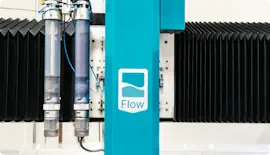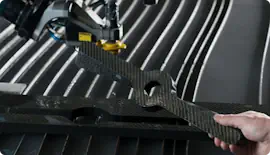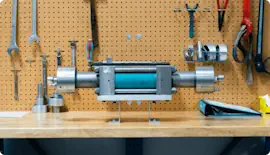How It All Began: The Origins of Waterjet
Most origin stories seem to be either extremely far-fetched or particularly ordinary. Waterjet’s genesis falls somewhere in the middle.
The technology we know today – used for numerous applications, including cutting stone, steel, and glass – has evolved significantly since it was developed in the 1950s, initially used to cut lumber from trees.
Over time, more use cases were added and, within the last couple of decades, automation has created additional efficiencies for machine operators and the ability to produce more precise cuts.
While the waterjet industry doesn’t include an Archimedes “eureka” moment or a Steve Jobs-esque garage-based origin story, its history does offer its own interesting set of twists and turns.
Here’s how waterjet got its start and became one of the most effective tools in the fabrication industry.
Waterjet got its start cutting trees.
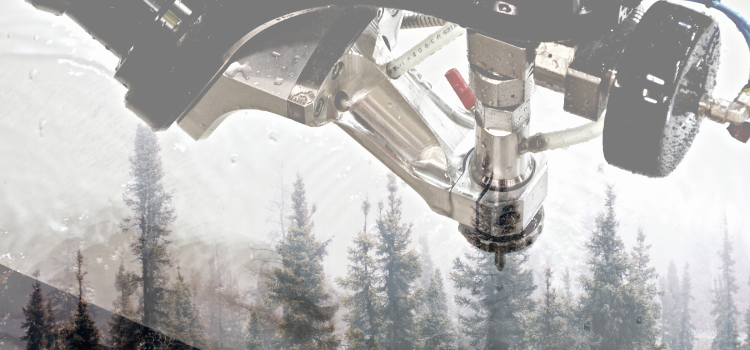.png)
Dr. Norman Franz was a forestry engineer who wanted to find a more efficient way to produce lumber. In the 1950s, Franz did just that: he figured out that pressurized water could create a supersonic stream capable of cutting through trees. He used a polymer injection pump, created by McCartney, to create a continuous stream.
The early models of waterjets largely dealt with materials like cardboard, paper, fiberglass home insulation, disposable diapers, and other softer substances.
The novel cutting machine was no doubt an impressive invention; however, it had not yet reached its full potential.
Dr. Mohamed Hashish was a PhD student interested in waterjet technology. In particular, he wanted to increase waterjet’s power – in the 1970s when Hashish was working on his doctorate, the technology was still only able to cut soft materials.
One night, while leaving work, Hashish developed an idea that involved his coffee cup and an ashtray. Here’s how he describes it:
“My first try making an abrasive waterjet was while I was writing my thesis on the theory of waterjet cutting. I was going home around 8:30 PM and somehow I noticed the shiny material in the ash tray next to the elevator. My Styrofoam coffee cup was almost empty. I quickly finished the rest of the coffee and scooped some of this shiny material into the cup. Instead of going down to the lobby, I went to the basement where the waterjet machine was. I fired it up and put a piece of wood under the jet to pierce it and repeated the same test with the grit-filled Styrofoam cup in between the nozzle and the wood. It went faster through the wood but made some mess. I knew then what I wanted to do after I finished my degree. I made a list to Flow Research about many projects that I would like to do if I joined them. On the top of the list was adding abrasives to the jet. There were many other ridiculous ideas that I do not want to ever mention.
I approached the Late Dr. Mike Pao (then the CEO of Flow Industries) about the need to cut steel, concrete, and hard materials by adding abrasives to the waterjet. He was skeptical, but I made a bet with him. I asked for a 3 months period to try to make a working abrasive laden waterjet. We won the bet: a dinner for me and my wife. At that dinner, I gave him a piece of steel with his name crudely cut in Chinese.”
Hashish’s idea to add garnet to waterjet’s stream changed the technology completely. Now, armed with abrasive, waterjet machines can cut through materials that were unthinkable applications during waterjet’s infancy: Steel, stone, and composite, for example.
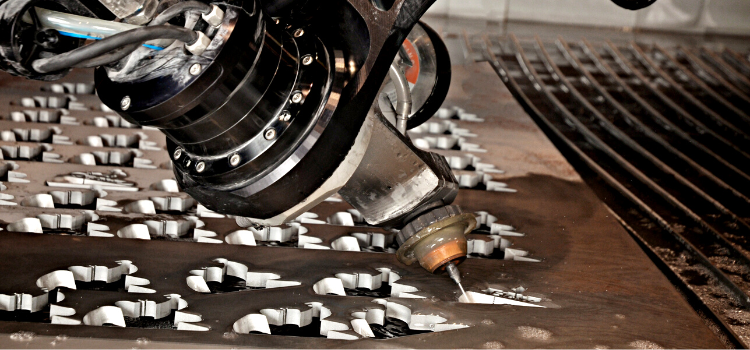.png)
Today, waterjet is a favorite cutting tool among fabricators looking for an efficient process and precise results. In addition, digital tools have made the process even stronger – stream lag and taper are no longer issues waterjet machines face, for example.
Learn more about the history of waterjet and its numerous use cases on Flow’s blog.
The technology we know today – used for numerous applications, including cutting stone, steel, and glass – has evolved significantly since it was developed in the 1950s, initially used to cut lumber from trees.
Over time, more use cases were added and, within the last couple of decades, automation has created additional efficiencies for machine operators and the ability to produce more precise cuts.
While the waterjet industry doesn’t include an Archimedes “eureka” moment or a Steve Jobs-esque garage-based origin story, its history does offer its own interesting set of twists and turns.
Here’s how waterjet got its start and became one of the most effective tools in the fabrication industry.
Coming out of the Woods
Waterjet got its start cutting trees..png)
Dr. Norman Franz was a forestry engineer who wanted to find a more efficient way to produce lumber. In the 1950s, Franz did just that: he figured out that pressurized water could create a supersonic stream capable of cutting through trees. He used a polymer injection pump, created by McCartney, to create a continuous stream.
The early models of waterjets largely dealt with materials like cardboard, paper, fiberglass home insulation, disposable diapers, and other softer substances.
The novel cutting machine was no doubt an impressive invention; however, it had not yet reached its full potential.
Adding Garnet: A New World of Possibilities
An ashtray changed the course of waterjet history.Dr. Mohamed Hashish was a PhD student interested in waterjet technology. In particular, he wanted to increase waterjet’s power – in the 1970s when Hashish was working on his doctorate, the technology was still only able to cut soft materials.
One night, while leaving work, Hashish developed an idea that involved his coffee cup and an ashtray. Here’s how he describes it:
“My first try making an abrasive waterjet was while I was writing my thesis on the theory of waterjet cutting. I was going home around 8:30 PM and somehow I noticed the shiny material in the ash tray next to the elevator. My Styrofoam coffee cup was almost empty. I quickly finished the rest of the coffee and scooped some of this shiny material into the cup. Instead of going down to the lobby, I went to the basement where the waterjet machine was. I fired it up and put a piece of wood under the jet to pierce it and repeated the same test with the grit-filled Styrofoam cup in between the nozzle and the wood. It went faster through the wood but made some mess. I knew then what I wanted to do after I finished my degree. I made a list to Flow Research about many projects that I would like to do if I joined them. On the top of the list was adding abrasives to the jet. There were many other ridiculous ideas that I do not want to ever mention.
I approached the Late Dr. Mike Pao (then the CEO of Flow Industries) about the need to cut steel, concrete, and hard materials by adding abrasives to the waterjet. He was skeptical, but I made a bet with him. I asked for a 3 months period to try to make a working abrasive laden waterjet. We won the bet: a dinner for me and my wife. At that dinner, I gave him a piece of steel with his name crudely cut in Chinese.”
Hashish’s idea to add garnet to waterjet’s stream changed the technology completely. Now, armed with abrasive, waterjet machines can cut through materials that were unthinkable applications during waterjet’s infancy: Steel, stone, and composite, for example.
.png)
Moving Forward
Waterjet has come a long way since Dr. Franz’s first applications in the 1950s. But at its core, the idea behind the technology remains the same: to effectively cut materials without the need for any secondary finish.Today, waterjet is a favorite cutting tool among fabricators looking for an efficient process and precise results. In addition, digital tools have made the process even stronger – stream lag and taper are no longer issues waterjet machines face, for example.
Learn more about the history of waterjet and its numerous use cases on Flow’s blog.
